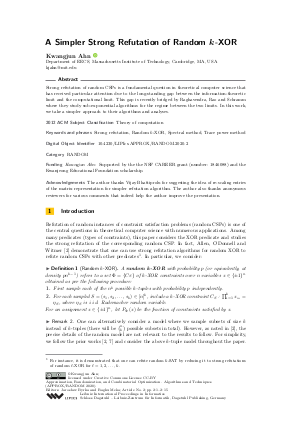A Simpler Strong Refutation of Random k-XOR
Author
Kwangjun Ahn 
-
Part of:
Volume:
Approximation, Randomization, and Combinatorial Optimization. Algorithms and Techniques (APPROX/RANDOM 2020)
Part of: Series: Leibniz International Proceedings in Informatics (LIPIcs)
Part of: Conference: International Conference on Randomization and Computation (RANDOM)
Part of: Conference: International Conference on Approximation Algorithms for Combinatorial Optimization Problems (APPROX) - License:
 Creative Commons Attribution 3.0 Unported license
Creative Commons Attribution 3.0 Unported license
- Publication Date: 2020-08-11
File

PDF
LIPIcs.APPROX-RANDOM.2020.2.pdf
- Filesize: 0.53 MB
- 15 pages
Document Identifiers
Subject Classification
ACM Subject Classification
- Theory of computation
Keywords
- Strong refutation
- Random k-XOR
- Spectral method
- Trace power method
Metrics
- Access Statistics
-
Total Accesses (updated on a weekly basis)
0Document
0Metadata
Abstract
Strong refutation of random CSPs is a fundamental question in theoretical computer science that has received particular attention due to the long-standing gap between the information-theoretic limit and the computational limit. This gap is recently bridged by Raghavendra, Rao and Schramm where they study sub-exponential algorithms for the regime between the two limits. In this work, we take a simpler approach to their algorithms and analyses.
Cite As Get BibTex
Kwangjun Ahn. A Simpler Strong Refutation of Random k-XOR. In Approximation, Randomization, and Combinatorial Optimization. Algorithms and Techniques (APPROX/RANDOM 2020). Leibniz International Proceedings in Informatics (LIPIcs), Volume 176, pp. 2:1-2:15, Schloss Dagstuhl – Leibniz-Zentrum für Informatik (2020)
https://doi.org/10.4230/LIPIcs.APPROX/RANDOM.2020.2
BibTex
@InProceedings{ahn:LIPIcs.APPROX/RANDOM.2020.2,
author = {Ahn, Kwangjun},
title = {{A Simpler Strong Refutation of Random k-XOR}},
booktitle = {Approximation, Randomization, and Combinatorial Optimization. Algorithms and Techniques (APPROX/RANDOM 2020)},
pages = {2:1--2:15},
series = {Leibniz International Proceedings in Informatics (LIPIcs)},
ISBN = {978-3-95977-164-1},
ISSN = {1868-8969},
year = {2020},
volume = {176},
editor = {Byrka, Jaros{\l}aw and Meka, Raghu},
publisher = {Schloss Dagstuhl -- Leibniz-Zentrum f{\"u}r Informatik},
address = {Dagstuhl, Germany},
URL = {https://drops.dagstuhl.de/entities/document/10.4230/LIPIcs.APPROX/RANDOM.2020.2},
URN = {urn:nbn:de:0030-drops-126053},
doi = {10.4230/LIPIcs.APPROX/RANDOM.2020.2},
annote = {Keywords: Strong refutation, Random k-XOR, Spectral method, Trace power method}
}
Author Details
Funding
- Ahn, Kwangjun: Supported by the the NSF CAREER grant (number: 1846088) and the Kwanjeong Educational Foundation scholarship.
Acknowledgements
The author thanks Vijay Bhattiprolu for suggesting the idea of re-scaling entries of the matrix representation for simpler refutation algorithm. The author also thanks anonymous reviewers for various comments that indeed help the author improve the presentation.
References
- Kwangjun Ahn, Dhruv Medarametla, and Aaron Potechin. Graph matrices: Norm bounds and applications. arXiv, 2020. URL: http://arxiv.org/abs/1604.03423.
-
Sarah R Allen, Ryan O'Donnell, and David Witmer. How to refute a random CSP. In Proceedings of the 56th FOCS, pages 689-708. IEEE, 2015.

-
Boaz Barak and Ankur Moitra. Noisy tensor completion via the sum-of-squares hierarchy. In COLT, pages 417-445, 2016.

-
Vijay Bhattiprolu, Venkatesan Guruswami, and Euiwoong Lee. Sum-of-Squares Certificates for Maxima of Random Tensors on the Sphere. In APPROX/RANDOM 2017, volume 81, pages 31:1-31:20. LIPIcs, 2017.

-
Amin Coja-Oghlan, Andreas Goerdt, and André Lanka. Strong refutation heuristics for random k-SAT. Combinatorics, Probability and Computing, 16(1):5-28, 2007.

-
Charles Delorme and Svatopluk Poljak. The performance of an eigenvalue bound on the max-cut problem in some classes of graphs. Discrete Mathematics, 111(1-3):145-156, 1993.

- Prasad Raghavendra, Satish Rao, and Tselil Schramm. Strongly refuting random CSPs below the spectral threshold. In Proceedings of the 49th STOC, pages 121-131. ACM, 2017. URL: http://arxiv.org/abs/1605.00058.
-
Joel A Tropp. User-friendly tail bounds for sums of random matrices. Foundations of computational mathematics, 12(4):389-434, 2012.

-
Alexander S Wein, Ahmed El Alaoui, and Cristopher Moore. The kikuchi hierarchy and tensor pca. In Proceedings of the 60th FOCS, pages 1446-1468. IEEE, 2019.

